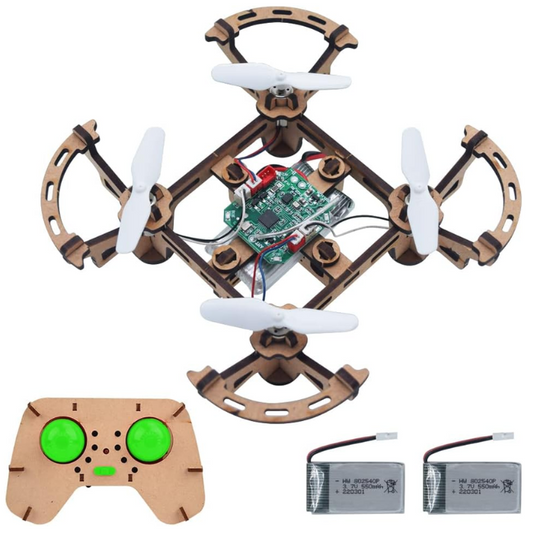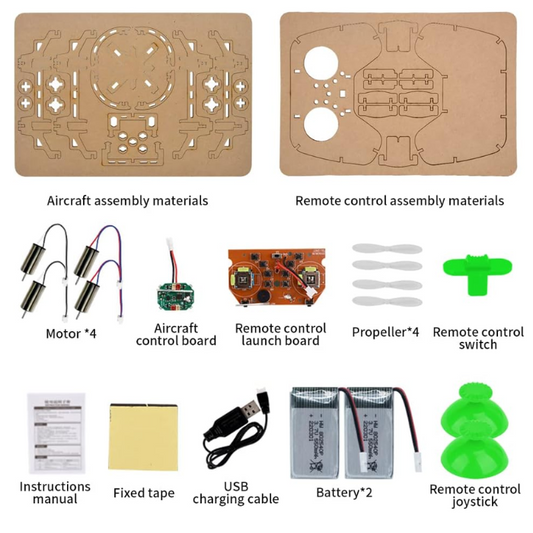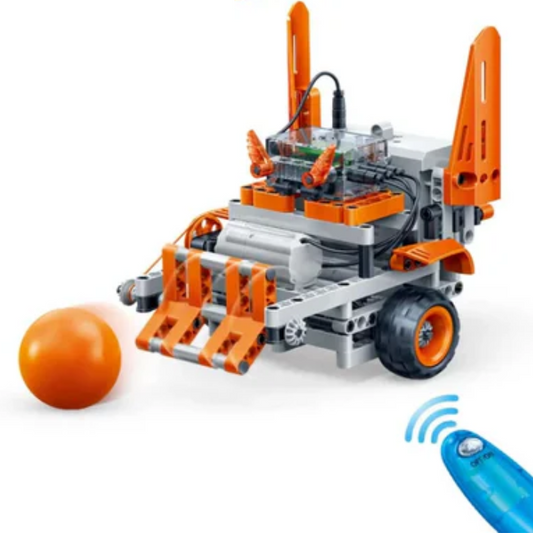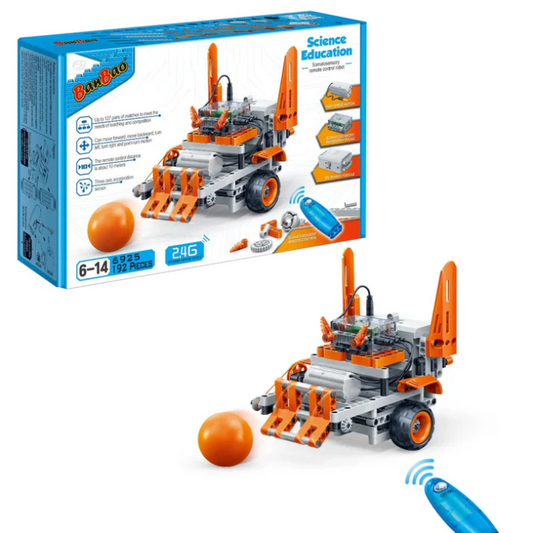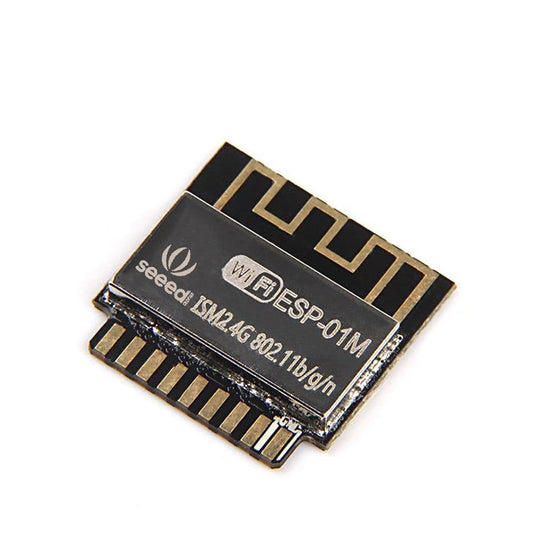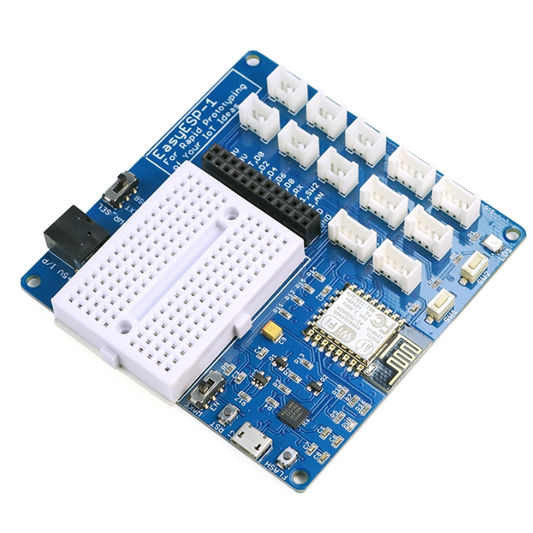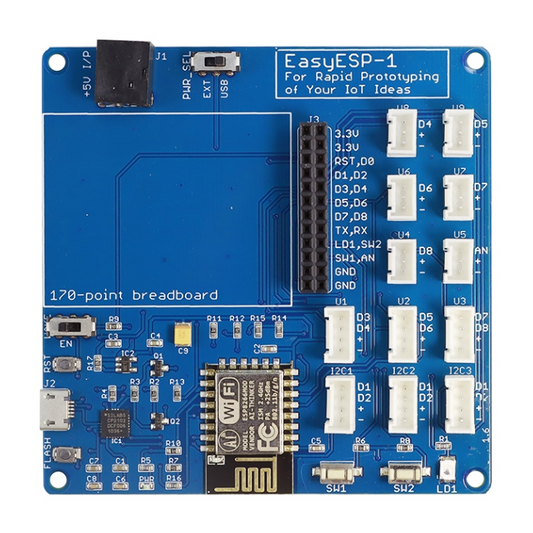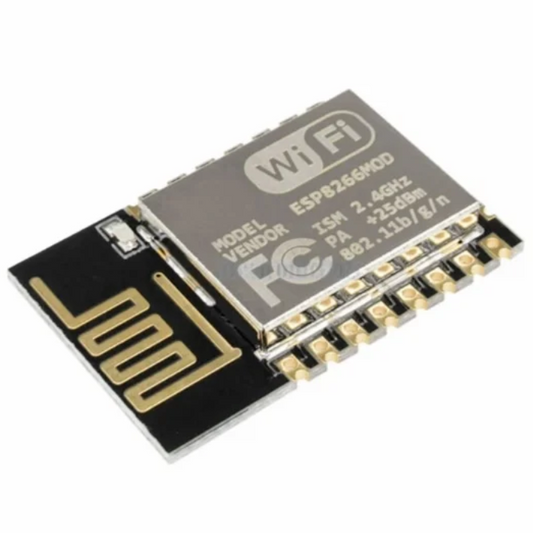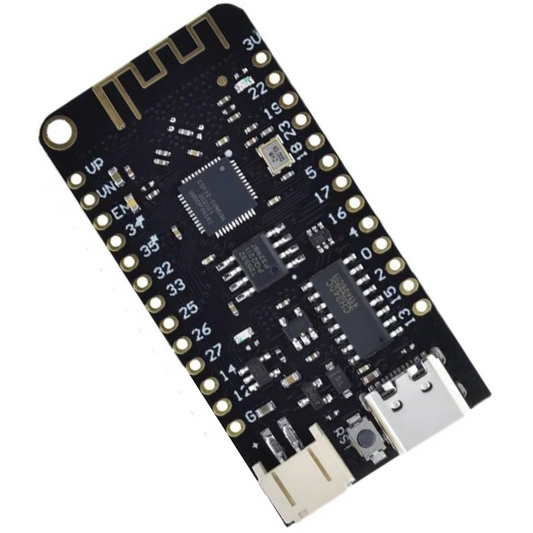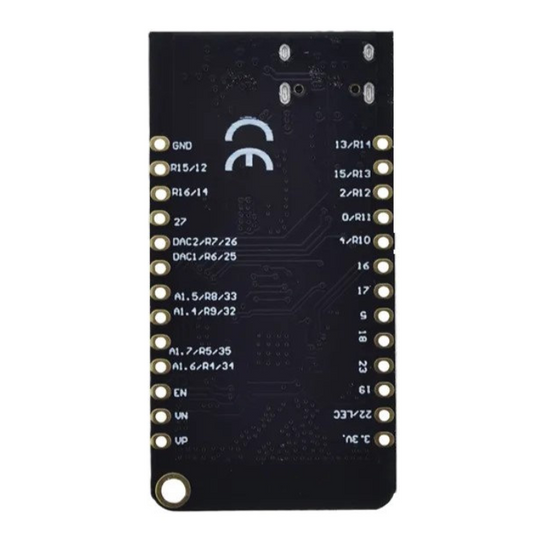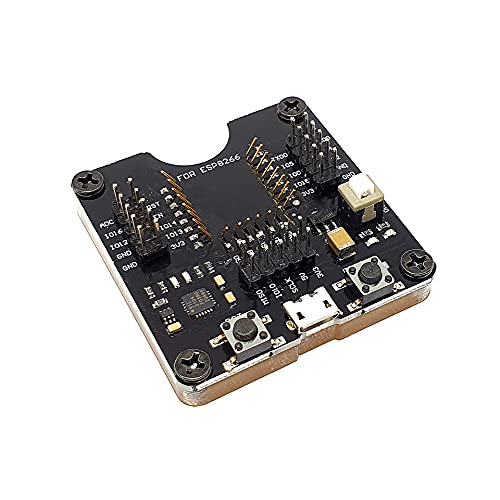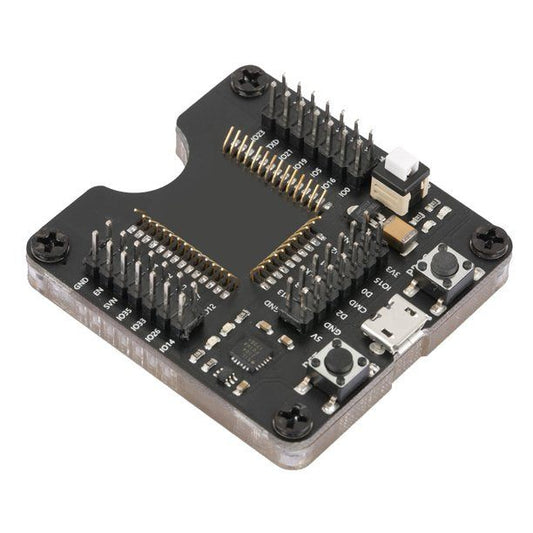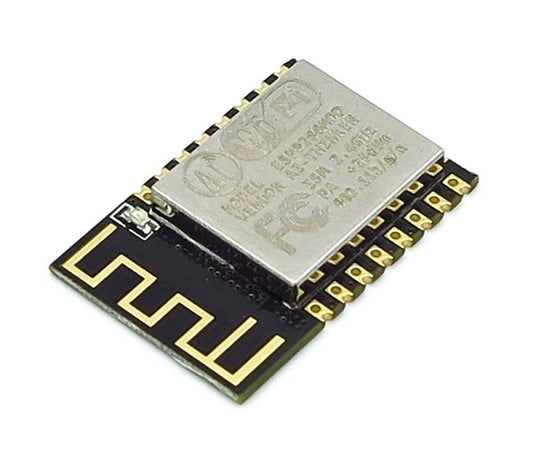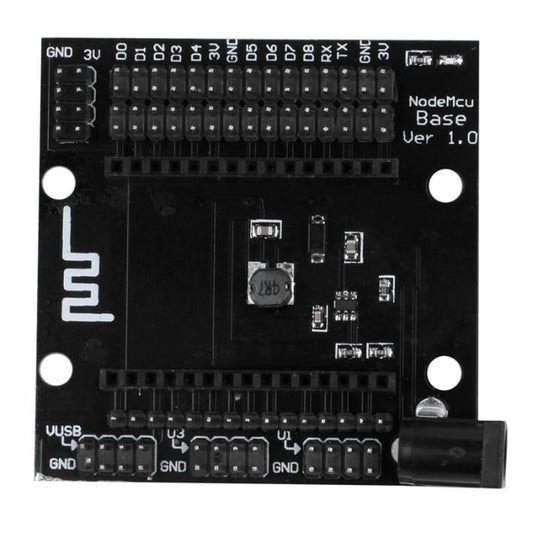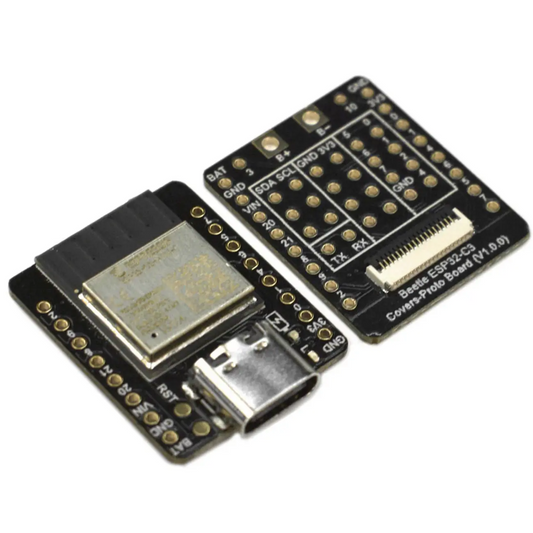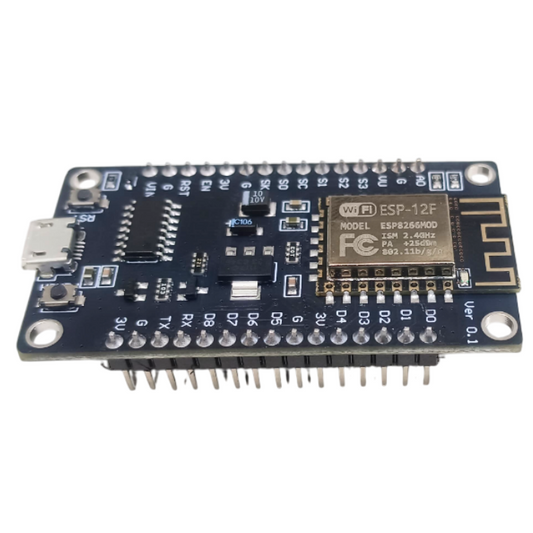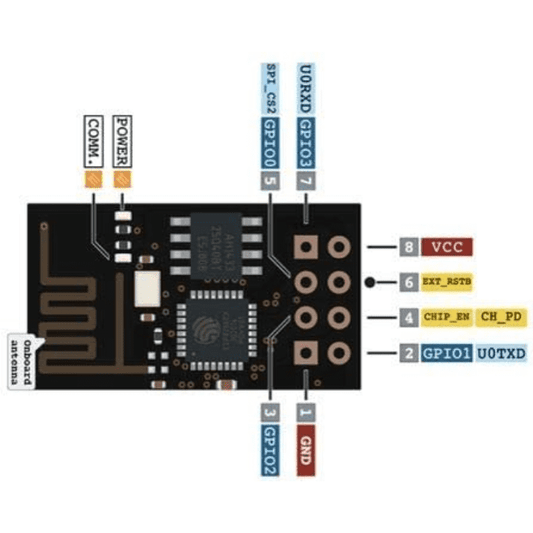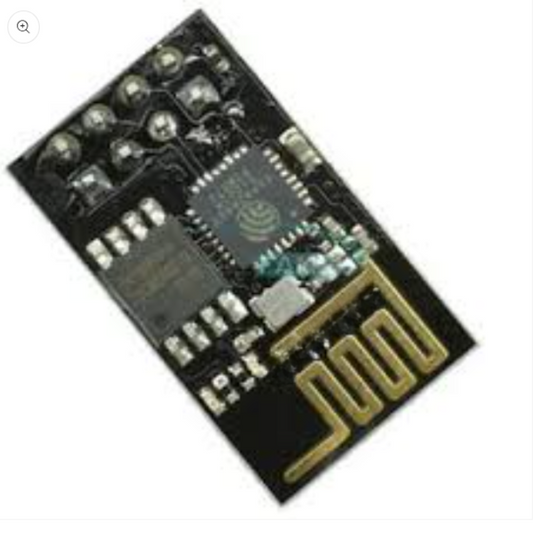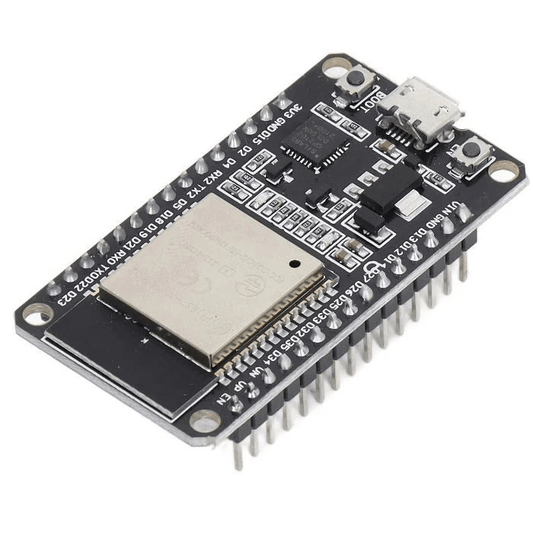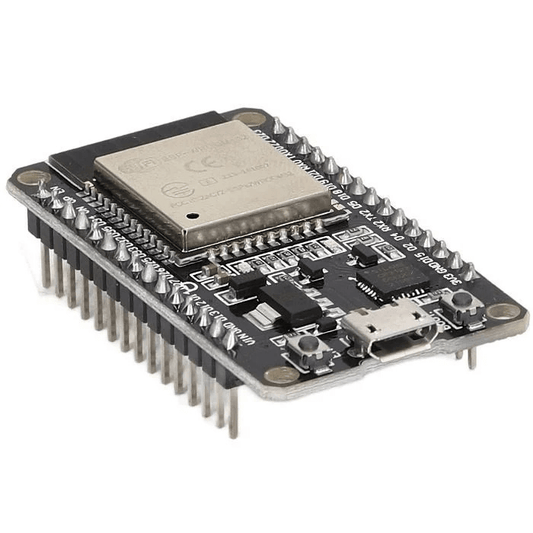- 10
- 15
- 20
- 25
- 30
- 50
- Featured
- Best selling
- Alphabetically, A-Z
- Alphabetically, Z-A
- Price, low to high
- Price, high to low
- Date, old to new
- Date, new to old
Sort by:
- Featured
- Best selling
- Alphabetically, A-Z
- Alphabetically, Z-A
- Price, low to high
- Price, high to low
- Date, old to new
- Date, new to old
-
Witty Cloud ESP12F ModuleWitty Cloud ESP12F ESP8266 Serial WiFi Development Board (Mini Node MCU Module) The ESP8266/ ESP-12F Module/ Serial WIFI Witty Cloud Development Board + MINI nodeMCU is a cheap and small Wifi transceiver, a perfect solution for Home Automation and IoT applications. It can be the replacement for...
- Rs. 241
Rs. 349- Rs. 241
- (-31%)
- Unit price
- / per
Save Rs. 108 -
ESP8285 Wi-Fi SoC ModuleESP8285 Wi-Fi SoC Module The ESP8285 has a unique design that allows flexibility while docking into existing products. It uses a DIP plug in a package that makes it suitable for automation, large-scale, modern production of low-cost, convenient applications in various networking hardware terminal...
- Rs. 234
Rs. 399- Rs. 234
- (-41%)
- Unit price
- / per
Save Rs. 165 -
WiFi Kit 32WiFi Kit 32 WiFi Kit 32 is a classic IoT dev-board designed & produced by Heltec Automation(TM), it’s a highly integrated product based on ESP32 (include Wi-Fi and BLE), Li-Po battery management system, 0.96? OLED is also included. It’s the best choice for smart...
- Rs. 1,345
Rs. 1,980- Rs. 1,345
- (-32%)
- Unit price
- / per
Save Rs. 635 -
ELECROW EasyESP-1: Rapid Prototyping WiFi ESP8266 Experimenter Board - Easy Programming, GPIO Access, BreadboardELECROW EasyESP-1: Rapid Prototyping WiFi ESP8266 Experimenter Board - Easy Programming, GPIO Access, Breadboard ELECROW EasyESP-1 is the perfect solution for beginners diving into IoT and electronics projects. It is equipped with features like easy programming, GPIO access, breadboard experimentation, and more. Made in...
- Rs. 3,608
Rs. 4,999- Rs. 3,608
- (-28%)
- Unit price
- / per
Save Rs. 1,391 -
ESP8266 Serial WIFI Wireless Transceiver Module ESP-07 Send Receive LWIP AP Plus STAESP8266 Serial WIFI Wireless Transceiver Module ESP-07 Send Receive LWIP AP Plus STA The ESP-07 WiFi module is developed by AI-Thinker Co., Ltd, has an ultra-low power 32-bit MCU micro, with a 16-bit short mode, clock speed support 80 MHz, 160 MHz, supports the RTOS,...
- Rs. 219
Rs. 263- Rs. 219
- (-17%)
- Unit price
- / per
Save Rs. 44 -
ESP12E ESP8266 Wireless Transceiver ModuleESP12E ESP8266 Wireless Transceiver Module The ESP12E ESP8266 is a highly integrated chip designed for the needs of a new connected world. This esp module offers a complete and self-contained Wi-Fi networking solution, allowing it to either host the application or offload all Wi-Fi networking functions...
- Rs. 106
Rs. 161- Rs. 106
- (-34%)
- Unit price
- / per
Save Rs. 55 -
ESP32 CP2102 Wireless Development Board D1 LOLIN32ESP32 CP2102 Wireless Development Board D1 LOLIN32 The D1 LOLIN32 ESP32 CP2102 Wireless Development Board is a small yet powerful device that improves the adaptability and effectiveness of your Internet of Things projects. Based on the reliable ESP-32 chip, this board has 4MB of...
- Rs. 450
Rs. 599- Rs. 450
- (-25%)
- Unit price
- / per
Save Rs. 149 -
ESP8266 Wroom Downloader Burning Fixture Tool Programming BoardESP8266 Wroom Burning Fixture Tool Downloader The ESP8266 development fixture board can be used to program ESP8266 chips for development and small-batch production. The development board comprises fixtures for the ESP32 modules with an inbuilt CP2104 USB-TTL chip and an AMS1117 3.3 version regulator...
- Rs. 625
Rs. 699- Rs. 625
- (-11%)
- Unit price
- / per
Save Rs. 74 -
ESP32 MH-ET Live ModuleESP32 MH-ET Live Module The ESP32 is already an integrated antenna and RF balun, power amplifier, low-noise amplifiers, filters, and power management module. The entire solution takes up the least amount of printed circuit board area. This ESP board is used with 2.4 GHz dual-mode...
- Rs. 722
Rs. 919- Rs. 722
- (-21%)
- Unit price
- / per
Save Rs. 197 -
ESP32 Wroom Programming JigESP32 Wroom Programming Jig This module is suitable for testing or burning firmware to the ESP WROOM 32 chips. All IO ports have LEDs which enables this module to act as a minimum system board to test all GPIO pins. It does support a...
- Rs. 570
Rs. 762- Rs. 570
- (-25%)
- Unit price
- / per
Save Rs. 192 -
ESP8266 12FESP8266 12F ESP8266 is high integration wireless SOCs, designed for space and power-constrained mobile platform designers. It provides unsurpassed ability to embed Wi-Fi capabilities within other systems or to function as a standalone application, with the lowest cost, and minimal space requirement. It is...
- Rs. 99
Rs. 148- Rs. 99
- (-33%)
- Unit price
- / per
Save Rs. 49 -
Lolin Node MCU baseLolin Node MCU base The NodeMcu Lua WIFI Development Board ESP8266 Serial Port Baseboard is a networking platform that is open source. It is programmed in the Lua scripting language. This baseboard is the Breakout Board for our NodeMcu ESP8266 V3 Lua CH340 Wifi Dev. Allows...
- Rs. 103
Rs. 149- Rs. 103
- (-31%)
- Unit price
- / per
Save Rs. 46 -
Beetle ESP32 - C3 (RISC-V Core Development Board)Beetle ESP32 - C3 (RISC-V Core Development Board) Beetle ESP32-C3, a compact IoT solution ideal for wearables, sports projects, and more. With mini size, safety features, dual-mode communication, and comprehensive tutorials, this controller ensures seamless integration into diverse applications. Made for IoT enthusiasts, it...
- Rs. 764
Rs. 1,499- Rs. 764
- (-49%)
- Unit price
- / per
Save Rs. 735 -
ESP12F ESP8266 Amica NodeMCU Wifi Module CH340ESP12F ESP8266 Amica NodeMCU Wifi Module CH340 A great set of tools to develop ESP8266. NodeMCU is built based on the mature ESP8266 technology to take advantage of the abundant resources available on the web. NodeMCU has ESP-12-based serial WiFi integrated onboard to provide...
- Rs. 263
Rs. 349- Rs. 263
- (-25%)
- Unit price
- / per
Save Rs. 86 -
ESP01 ESP8266 Wireless Transceiver ModuleESP01 ESP8266 Wireless Transceiver Module Hey, have you seen the ESP-01 ESP8266 WiFi Module? It’s a simple way to connect any microcontroller to WiFi since it has everything built in. You can run your own programs on it or let it handle the Wi-Fi...
- Rs. 109
Rs. 156- Rs. 109
- (-30%)
- Unit price
- / per
Save Rs. 47 -
ESP32 Node MCU Development Board with Wifi and Bluetooth (CP2102 Driver, 30 PIN)ESP32 (CP2102 Driver, 30 Pin) WiFi + Bluetooth NodeMCU-32 Development Board) Looking to supercharge your IoT projects? The ESP32 Node MCU Development Board with Wi-Fi and Bluetooth (CP2102) is your go-to solution. And the best part? You can buy it now at an unbeatable...
- Rs. 341
Rs. 497- Rs. 341
- (-31%)
- Unit price
- / per
Save Rs. 156 -
ESP32 (38 Pin) WiFi + Bluetooth NodeMCU-32 Development BoardESP32 (38 Pin) WiFi + Bluetooth NodeMCU-32 Development Board The ESP32 development board promises to revolutionize the Internet of Things (IoT), creating a powerful and reliable platform for low-cost, highly integrated applications. Featuring an open-source operating system, built-in Wi-Fi, and Bluetooth support, along with...
- Rs. 336
Rs. 519- Rs. 336
- (-35%)
- Unit price
- / per
Save Rs. 183 -
ESP32 LoRa with Display - 863MHz-928MHz SX1276ESP32 LoRa with Display ESP32 LoRa with Display - 863MHz-928MHz SX1276 is a development board for IoT projects that includes an ESP32 microprocessor, a SX1276 LoRa node chip, and a 0.96-inch OLED display.ESP32 LoRa with Display operates on frequencies between 863MHz and 928MHz and...
- Rs. 1,812
Rs. 2,683- Rs. 1,812
- (-32%)
- Unit price
- / per
Save Rs. 871 -
ESP32-WROVER Development Fixture BoardESP32-WROVER Development Fixture Board The ESP32-WROVER Development Fixture Board is the ultimate solution for developers working with ESP32-WROVER chips. This compact board is designed for easy and efficient programming, offering one-click firmware download and support for bulk programming without the need for individual chip...
- Rs. 618
Rs. 869- Rs. 618
- (-29%)
- Unit price
- / per
Save Rs. 251 -
Airgain N2420 2.4 Ghz 4DB WiFi Omnidirectional Antenna - IPEX-IPX (Set of 2)Airgain N2420 2.4 Ghz 4DB WiFi Omnidirectional Antenna 2.4GHz built-in PCB antenna N2420, is our company's well-designed dipole PCB antenna, the gain is up to 3.5dBi (+/-0.5), the effect is comparable to the external rod-shaped omnidirectional antenna. The wire uses a low-loss high-frequency coaxial...
- Rs. 77
Rs. 109- Rs. 77
- (-29%)
- Unit price
- / per
Save Rs. 32
ESP Modules are ideal for diverse application scenarios like Internet of Things (IoT), wearable electronics, and smart homes, ESP Modules come in an array of form factors such as development boards, breakout boards, and modules. These modules can be effortlessly programmed using either the Arduino IDE or the Espressif IoT Development Framework (IDF).
Preferred by developers seeking a hassle-free and dependable Wi-Fi solution, ESP Modules also serve as a cost-effective means of incorporating Wi-Fi into projects. When searching for an affordable, user-friendly, and reliable Wi-Fi solution, look no further than ESP Modules. Their advantages include seamless integration, dependability, exceptional RF performance, compact design, and comprehensive certification.
Explore our extensive collection of the newest ESP WiFi Modules from top brands like Espressif, ELECROW, Seeed Studio, Witty Fox, Waveshare, NodeMCU, and more including popular versions such as the ESP8266 and ESP32. Enjoy hassle-free online shopping with easy navigation, complete product descriptions, fast shipping, low prices without sacrificing quality, and professional advice to help you select the best ESP Module for your project.
Robocraze is the ultimate destination and trusted supplier of ESP modules, development boards, and other electronic components.
Prices of ESP WIFI Modules
Product | Price |
Rs.485 | |
Rs.126 | |
Rs.129 | |
Rs.419 | |
Rs.222 | |
ESP32 Node MCU Development Board with Wifi and Bluetooth (CP2102 Driver, 30 PIN) | Rs.389 |
Rs.225 | |
Rs.334 | |
Rs.836 | |
Rs.310 | |
Rs.344 | |
Rs.134 | |
Wii-Link N2450 2.4 Ghz 4DB WiFi Omnidirectional Antenna - IPEX-IPX (Set of 2) | Rs.169 |
Rs.2230 | |
Rs.177 | |
Rs.841 | |
Witty Fox - ESP32 Storm Board with On-Board Li-ion Battery & Wireless Programming | Rs.1157 |
Rs.223 | |
Rs.1116 | |
Rs.211 | |
Rs.174 | |
Rs.287 | |
Rs.331 | |
Rs.125 | |
Rs.1139 | |
Rs.839 | |
Rs.2044 | |
Rs.1699 | |
Rs.278 | |
Rs.125 | |
Rs.758 |
Other Categories
LORA | WIFi Switches | GSM/GPRS | BLE Bluetooth beacons | RF/NRF | RFID/NFC | XBee | DTMF & IR | Smart Products | Types of Sensors in IoT
Popular Searches
Raspberry Pi | M5Stack | Development Boards | DIY Kits | 3D Printers/Pens | Arduino | Sensors | Electronic Components | Drones/UAV | Motors & Mechanical | Displays | Batteries & Power Supply | Tools & Instruments | Cables & Connectors | Prototyping & Misc | IOT & Wireless
1.What is the ESP WiFi Module in IoT?
- ESP is a microcontroller by a company called Expressif. They mainly come in two versions ESP8266 (NodeMCU) and it’s successor, the more powerful ESP32. Both ESP are compact and have in built Wifi in them allowing you to make it the main brains of any IoT product
2.What are the types of ESP WiFi Modules?
- ESP’s come in mainly two types ESP8266 & ESP32. They vary in their specs, with ESP32 being the more powerful version. Other boards are based on one of these two microcontrollers like the ESP32 Cam module which is a camera module with ESP32 built in.
3.What does an ESP WiFi Module do?
- ESP modules can be programmed to do anything. It is considered as a better version of Arduino as it has features like built-in wifi, compact design and many GPIO pins for interfacing. It is suitable for most IoT products
4.Which ESP WiFi module is the best for a robotics project?
- ESP32 might be better suited for robotics as it has a more powerful dual core processor, bluetooth and a lot more GPIO pins to interface with various sensors and actuators that may be required in a robotics project - as compared to ESP8266
Things to Consider before buying ESP-8266
1.How does ESP8266 work?
- ESP8266 is a microcontroller that can be programmed using an Arduino IDE or ESP-IDF. It is developed by Expressif and can be used for various purposes.
2.What is the range of the ESP8266 WiFi Module?
- With the built-in antenna, the ESP only has a range of about a couple of meters. However the range can be extended using an external antenna.
3.How do I test the ESP8266 8266WiFi Module?
- You can check whether the ESP module is fully functioning by running an example code under ESP8266Wifi called “Wifi Scan” provided in the ESP8266 library. This will scan for available wifi networks and print it out on your serial monitor. Thus you can ensure that the module works as the way it should
4.How can I connect the ESP 8266 WiFi Module to Arduino
- ESP8266 can be connected to Arduino via the UART pins.
- Enable SoftwareSerial on Arduino via IDE and connect the Tx and Rx pins of the ESP module to the Rx and Tx you have defined in your code
- VCC of ESP has to be connected to 3.3V
- GND of the ESP needs to be connected to GND of Arduino
- With UART line enabled, you can share any information between ESP and the Arduino vial Serial.print() command in the Arduino IDE.
5.How do I connect an ESP 32 to WiFi?
- ESP32 can be connected to Wifi the same way as ESP8266. Assuming you have the ESP32 board installed in your Arduino IDE, you can proceed to write the below code, replacing the ssid and password with your own network’s
#include "WiFi.h"
const char* ssid = "yourNetworkName";
const char* password = "yourNetworkPass";
void setup() {
Serial.begin(115200);
WiFi.begin(ssid, password);
while (WiFi.status() != WL_CONNECTED) {
delay(500);
Serial.println("Connecting to WiFi..");
}
Serial.println("Connected to the WiFi network");
}
void loop() {}
6.What is ESP 32 used for?
- ESP32 can be used for almost any IoT product. Due to their compact design and a lot of available features and GPIO pins, it is an ideal microcontroller to be used as the brains of any low powered device. It is a fantastic replacement for Arduino and an improved version of ESP8266.
7.What is the ESP32 camera Module?
- ESP32 Camera Module is a tiny camera that comes with an ESP32 chip as well as an SD Card. It was created by AIThinker and it is an integrated, cheap and all in one module in case you have a specific application of using cameras with a microcontroller.
8.What is the difference between ESP 32 and ESP 8266 WiFi Module?
- There are a few key differences in capability between EP8266 and ESP32 - ESP32 being the overall better version. Few of the main differences are listed below:
| ESP32 | ESP8266 |
| Dual Core Processor | Single Core Processor |
| Bluetooth 4.0 | No Bluetooth |
| 36 GPIO Pins | 17 GPIO Pine |
| 16 PWM Pins | 8 PWM Pins |
| 4 SPI Channels | 2 SPI Channels |
| Capable of supporting CAN networks | Does not support CAN Networks |
9. What is ESP32 and its main features?
ESP32 is an economical and power-efficient microcontroller that incorporates integrated Wi-Fi and dual-mode Bluetooth capabilities. It is developed by Espressif Systems, a Chinese company based in Shanghai, and manufactured by TSMC using their 40 nm process. The ESP32 serves as the successor to the ESP8266 microcontroller.
Key features of the ESP32 include:
- Processors: The ESP32 utilizes either a Tensilica Xtensa LX6 microprocessor, available in both dual-core and single-core variations, an Xtensa LX7 dual-core microprocessor, or a single-core RISC-V microprocessor.
- Memory: With 320 KiB RAM and 448 KiB ROM, the ESP32 offers ample memory resources for efficient operation.
- Wireless connectivity: The ESP32 comes equipped with built-in Wi-Fi, supporting compatibility with 802.11 b/g/n in the 2.4GHz band and achieving speeds of up to 150 Mbits/s. It also features dual-mode Bluetooth capabilities.
- Built-in peripherals: The ESP32 boasts an extensive array of integrated peripherals, including antenna switches, an RF balun, a power amplifier, a low-noise receive amplifier, filters, and power management modules. Additionally, it offers built-in timers, a watchdog, a real-time clock, ADC and DAC converters, a touch sensor, an ultra-low power (ULP) co-processor, and an Ethernet MAC interface.
- Robust design: Designed for industrial environments, the ESP32 is capable of reliable performance within an operating temperature range of –40°C to +125°C.
Furthermore, the ESP32 incorporates advanced features such as fine-grained clock gating, various power modes, and dynamic power scaling, enabling it to achieve exceptionally low power consumption. With its extensive range of built-in peripherals and wireless connectivity options, the ESP32 proves to be an excellent choice for developing connected products.
10. What programming languages can be used with ESP32?
ESP32 supports multiple programming languages, including C, C++, Python, Lua, JavaScript, Rust, TinyGo, and CircuitPython. The ESP32 SDK, which consists of libraries and tools for ESP32 application development, is primarily written in C. C is a low-level language that offers direct hardware access, making it a suitable choice for programming microcontrollers. MicroPython and CircuitPython are Python-based languages optimized for ESP microcontrollers. Lua is another popular language for ESP32 programming, with various JavaScript interpreters available. Additionally, Rust and TinyGo can be used for ESP32 programming. When it comes to programming environments, options include Espressif's IoT Development Framework (IDF), VSCode with PlatformIO, Eclipse, Visual Studio Code, Visual Micro, CLion, and Arduino IDE, which is compatible with many ESP32 boards and offers Arduino libraries.
11. What are some popular ESP32 IoT projects?
There are numerous popular IoT projects based on ESP32 that you can explore. Here are some examples:
- ESP32 LED web server: Create an ESP32-based LED web server from scratch.
- Smart electricity energy meter: Build an IoT-based smart electricity energy meter using ESP32 and Blynk 2.0.
- Indoor air quality analysis: Develop an indoor air quality analysis system using ESP32.
- Biometric door lock system: Construct an ESP32-based biometric door lock system using the R307 fingerprint sensor and Blynk IoT platform.
- Temperature and humidity monitoring and control system: Design a temperature and humidity monitoring and control system using ESP32 WiFi module and Blynk 2.0.
- Home automation: Build an IoT-based home automation project using ESP32 and New Blynk 2.0 IoT.
- ESP RainMaker: Develop an ESP32-based IoT project using ESP Rainmaker to control four appliances with Google Assistant, Alexa, and manual switches.
- ESP32-based music player: Create an ESP32-based music player for home automation.
- ESP32-based game console: Construct an ESP32-based game console.
- ESP32-OLED scrolling message display: Build an ESP32-OLED scrolling message display.
These projects cover a wide range of IoT applications, including home automation and air quality analysis.
12. How to troubleshoot common issues with ESP32?
Here are some typical issues you may encounter when working with ESP32 and their troubleshooting steps:
Failed to connect to ESP32: Ensure that your ESP32 is correctly connected to your computer and that you have selected the correct COM port in the Arduino IDE. You can also try resetting the ESP32 by pressing the EN button or power cycling it.
- Brownout detector or Guru meditation error: This error indicates a hardware problem, potentially caused by a power supply issue or a faulty ESP32. Try using a different power supply or replacing the ESP32.
- Sketch too big error: This error occurs when your sketch size exceeds the available flash memory on the ESP32. Reduce the sketch size by removing unnecessary code or using a different partition scheme.
- USB drivers are not installed: If you have trouble uploading sketches to your ESP32, ensure that the USB drivers are properly installed on your computer. You can also try using a different USB cable or port.
- Camera init failed with error 0x20001 or similar: This error suggests an issue with the camera module. Verify that the camera is correctly connected to the ESP32 and that you have selected the appropriate camera model in your code.
- Weak Wi-Fi signal: If you struggle to connect to a Wi-Fi network, ensure that the signal strength is sufficient. Consider moving the ESP32 closer to the router or using a Wi-Fi extender.
- Psram error: GPIO isr service is not installed: This error points to a problem with the PSRAM module. Confirm that the PSRAM is properly connected to the ESP32 and that you have enabled it in your code.
13. What is ESP8266 and how does it work?
The ESP8266, manufactured by Espressif Systems, is an economical Wi-Fi microchip. It integrates a Tensilica L106 32-bit microcontroller unit (MCU) with a Wi-Fi transceiver, enabling microcontrollers to establish connections with 2.4 GHz Wi-Fi networks through IEEE 802.11 bgn. It is compatible with ESP-AT firmware for facilitating Wi-Fi connectivity with external host MCUs. Alternatively, it can operate independently as an MCU using an RTOS-based SDK. Notably, the ESP8266 incorporates a comprehensive TCP/IP stack, facilitating data processing, GPIO control, and reading operations.
Highlighted below are the key features of the ESP8266:
- Integrated Wi-Fi Solution with Low Power Consumption: The ESP8266 is a self-contained SOC featuring an integrated TCP/IP protocol stack, empowering any microcontroller to access Wi-Fi networks.
- GPIO Pins: The ESP8266 offers 17 programmable GPIO pins, enabling remote control of LEDs or relays through internet connectivity.
- Analog Input: The ESP8266 includes a single analog input with a voltage range of 0 - 1.0V.
Each ESP8266 module comes pre-programmed with an AT command set firmware, facilitating its connection to Arduino devices and providing Wi-Fi connectivity. It can be managed through local Wi-Fi networks or accessed remotely via the internet (with port forwarding). The ESP8266 stands out as an exceptionally cost-effective board supported by a thriving and expanding community.
14. How can I set up ESP8266 for my IoT project?
To set up the ESP8266 for your IoT project, you can follow these general steps:
- Select your hardware: Various ESP8266 boards, such as the Wemos D1 Mini or NodeMCU, are accessible. Choose the board that best suits your project's prerequisites.
- Incorporate the ESP8266 board into the Arduino IDE: Utilize the Arduino Board Manager to set up the ESP8266. More comprehensive instructions are accessible on diverse websites.
- Establish a connection between the ESP8266 and your Wi-Fi network: Implement the ESP8266WiFi library to connect your ESP8266 to the designated Wi-Fi network. Ensure to provide the network's SSID and password.
- Compose your code: Employ the Arduino IDE or any compatible IDE to write your code. Abundant online examples and tutorials are available for reference.
- Verify your project: Upload the code to the ESP8266 and scrutinize the functionality of your project. Leverage serial communication to debug your code and monitor the project's output.
These steps serve as general guidelines, subject to variation based on the specific requirements of your project. An array of tutorials and examples can be found online, offering comprehensive assistance for initiating your ESP8266 project.
15. Can I use ESP8266 with other microcontrollers?
Yes, the ESP8266 possesses compatibility with other microcontrollers. Serving as a self-contained SOC, it integrates a TCP/IP protocol stack that permits any microcontroller to access your Wi-Fi network. The ESP8266 presents the flexibility of functioning independently or in conjunction with a microcontroller (MCU). With its built-in AT Command firmware, the module seamlessly interfaces with any MCU via the COM port. Moreover, the ESP8266 can furnish Wi-Fi connectivity to external host MCUs using ESP-AT firmware. Alternatively, it stands capable of operating as a self-reliant MCU by implementing an RTOS-based SDK. Featuring 17 GPIO pins, the ESP8266 offers programmable functionality to control LEDs or relays remotely via the internet. Notably, the ESP8266 affords control from your local Wi-Fi network or even from the internet (facilitated by port forwarding). As an added advantage, the ESP8266 stands as a remarkably cost-effective board, complemented by its thriving and expanding community. Consequently, the ESP8266 presents an ideal choice for integrating Wi-Fi connectivity and diverse functionalities into your IoT project when coupled with other microcontrollers.
16. Is ESP8266 compatible with different sensors and modules?
Yes, the ESP8266 demonstrates compatibility with a diverse range of sensors and modules. As an exceptionally adaptable microcontroller, the ESP8266 seamlessly interfaces with various sensors and modules. Leveraging its foundation on the ESP8266, it seamlessly integrates with the Arduino IDE through the board manager. Notably, the ESP8266 NodeMCU boards excel in compatibility with a wide array of sensors, modules, and peripherals. To establish connections between multiple sensors and the ESP8266, the utilization of an i2c A/D converter, such as the ADS1015, proves effective. Primarily employed in the development of embedded systems for IoT (Internet of Things), the ESP8266 assumes a dual role, effectively serving as either a host for applications or relieving the application processor of Wi-Fi networking functions. By skillfully integrating the ESP8266 with diverse sensors and modules, the successful realization of your IoT project becomes attainable.





